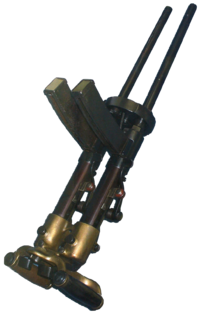| Villar-Perosa | |
|---|---|
 | |
| Type | Submachine gun |
| Place of origin |
|
| Service history | |
| Used by | See users |
| Wars | World War I |
| Production history | |
| Designed | 1914 |
| Specifications | |
| Mass | 6.5 kg (loaded short barreled version) |
| Length | 21 inches |
|
| |
| Cartridge | 9 mm Glisenti |
| Caliber | 9 mm |
| Barrels | 2 side by side |
| Action | blowback |
| Rate of fire | 3,000 round/min |
| Muzzle velocity | 1,050 ft/s (320 m/s)[citation needed] |
| Effective firing range | 1,800 m (2,200 yd)[citation needed] |
| Feed system | Box Magazine |
The Villar-Perosa aircraft submachine gun (official name FIAT mod. 1915) was an Italian double barreled light machine gun designed by Bethel Abiel Revelli, a Major in the Italian Army in 1914. The weapon fired pistol calibre 9 mm Glisenti ammunition, a reduced-power version of the famous 9 mm Para, at the extremely high rate of fire of 3,000 rounds per minute, or 1,500 rounds per minute per barrel. It was arguably the first submachine gun though it was highly impractical due to its design as a stationary machine gun.
History[]
Revelli applied for patents for the design on 8 April 1914, and subsequently assigned the patents to the Villar-Perosa company. The weapon was used by the Italian airforce and army during the First World War. Reportedly it was more successful in the ground role, as the pistol calibre bullets did not have sufficient striking power for bringing down aircraft.
A large number of the ground version of the weapon fell into the hands of German and Austrian forces following the Italian defeat at the Battle of Caporetto. The Austrians copied the weapon as the Sturmpistole M.18. using different magazines. As many soldiers found the weapon impractical, the Beretta firearm manufacturer cannibalized surviving examples to be converted into two single-barreled shoulder-fired weapons in 1918. Called the Beretta Model 1918, these weapons would see occasional battlefield use and are believed to account for the dearth of complete Villar Perosas today. The Italians produced a version called the OVP, which was basically a Villar-Perosa split in two. There was no grip forward of the magazine, so soldiers had to make do with whatever they could find.
A prototype was chambered in .455 Webley for trial purposes by the British.[1]
Description[]
The weapon consisted of two identical barrels and breech blocks (essentially two separate weapons) linked by a connecting cross bar. It was a simple air-cooled blow-back design with the bolt and striker weighing only ten ounces (280 grams). The total recoil travel was only 1.75 inches (4.5 cm) which, combined with the light, 10-ounce bolt, resulted in an extremely high rate of fire.
The weapon was fed from two curved magazines that could hold either 25 or 50 rounds each (the 50 round version was primarily used by aircraft). Each 'half' of the weapon operated with an independent trigger, so that they could be fired individually or simultaneously, as the user wished.
The weapon was relatively light with a loaded short barreled gun weighing just 14 pounds and 4 ounces (6.5 kg). However, it was virtually impossible to use in the advance because of the unique design of the triggers. Some soldiers experimented with mounting it on a harness carrier or to the handlebars of a bicycle (called Bersaglieri Ciclisti), but this was impractical.
Users[]
 Austria-Hungary, Captured examples.
Austria-Hungary, Captured examples.German Empire, Captured examples.
 Italy
ItalyUnited Kingdom, Trial purposes.
See also[]
- Flieger-Doppelpistole 1919, Swiss equivalent.
- Gast gun
References[]
- [1]
- [2]
- George M. Chinn, The Machine Gun. History, Evolution, and Development of Manual, Automatic, and Airborne Repeating Weapons, Volume I.
- Philip Schreier, The World's First Sub-Gun. Guns & Ammo Surplus Firearms, September 2009.
External links[]
- Defence Configuration
- Replica Aircraft Configuration
- Villar Perosa 9mm MOD.15 SMG
- Modern Firearms
- Springfield Armory's Villar Perosa
- VITTORIO BOBBA Pistola mitragliatrice Villar-Perosa mod. 1915 (Italian)
- http://www.kalashnikov.ru/upload/medialibrary/2cd/088_091.pdf
| ||||||||||||||||||||||||||||||||||||||||
The original article can be found at Villar-Perosa aircraft submachine gun and the edit history here.